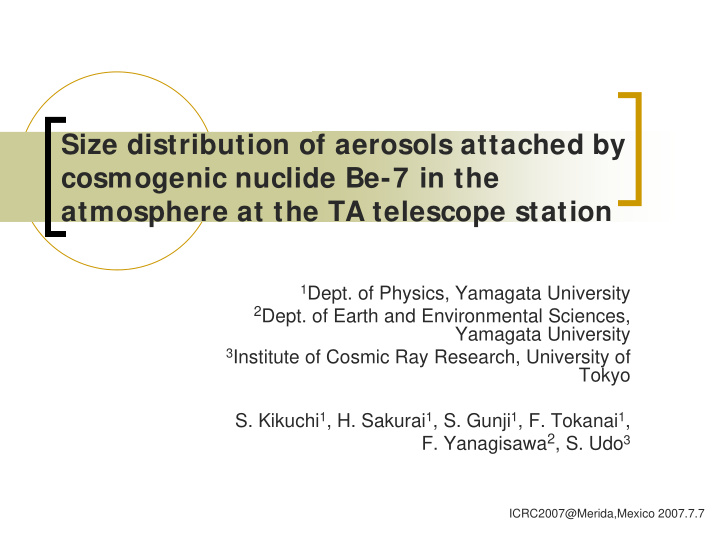



Size distribution of aerosols attached by cosmogenic nuclide Be-7 in the atmosphere at the TA telescope station 1 Dept. of Physics, Yamagata University 2 Dept. of Earth and Environmental Sciences, Yamagata University 3 Institute of Cosmic Ray Research, University of Tokyo S. Kikuchi 1 , H. Sakurai 1 , S. Gunji 1 , F. Tokanai 1 , F. Yanagisawa 2 , S. Udo 3 ICRC2007@Merida,Mexico 2007.7.7
Motivation � We have been studying a behavior of the cosmogenic nuclides in the atmosphere. � Topics � Observation of aerosols and Be-7 at TA telescope station � The relationship between Be-7 and aerosols size � The attachment rate of Be-7 to aerosols � The relationship between the Be-7 concentrations and the solar radiation.
Cosmogenic nuclide Be-7 and aerosols � Production Cosmic r ays collide with the atmospher ic elements 14 N(n,x) 7 Be 14 N(p,x) 7 Be Be-7 is produced 16 O(n,x) 7 Be 16 O(p,x) 7 Be Be -7 is o xidize d and attac he s to ae ro so ls. 40 Ar(n,x) 7 Be 40 Ar(p,x) 7 Be Aerosols with Be-7 fall down to the ground. � We collect the aerosols and measure the radioactivity of Be-7. 7 Be 53.28d 0.4776 10.3%(EC) detection 89.7%(EC) 0 7 Li Gamma ray: 477 keV
Observation � Location: On the roof of telescope building (13m above the ground) of “Telescope Array project” at Utah(39 ° N, 112 ° W, Alt.:1400m), USA (We contribute to the TA experiment of the highest energy cosmic rays by the study of aerosols in that area.) � Aerosol sampling : May.2006 Daily sampling of Be-7: From Oct. 2005 � The telescope building of TA project
Method Collection � Measurement � The low-level radioactivity � measurement of Be-7 by HPGe detector in the underground lab. Background Level: Andersen air sampler has 5 stages 0.006 cpm (on 1 equivalent to classify aerosol sizes. channel to Be-7’s 477 keV) • Range of classification on the each stage F1: 7.0 μ m~ 20 m under the ground F2: 3.3~7.0 (ICRR, Univ. of Tokyo) � The measurement of F3: 2.0~3.3 aerosols F4: 1.1~2.0 BC: < 1.1 μ m � Concentration � Size distribution
Flow particle image analyzer FPIA-2000 Size distribution of aerosols Aerosol particle imaging Measurement range: 0.60 ≤ equivalent diameter ≤ 400.0 [ μ m] The machine can’t measure water-soluble particles. Variation of aerosol size distribution TA0605227-28 TA060525-26 TA0605226-27 TA060523-24 27-28.May 25-26.May 23-24.May 26-27.May TA0605228-29 The sizes of all particles is less than φ 10μ m. Each distribution has 2 peaks at about 1 μ m and 3 μ m. Aerosol concentration [particles/m 3 ] 2.7x10 4 ~4.5x10 5 28-29.May The range of size distribution is similar to each other for any aerosol concentrations.
Aerosols concentration and barometric pressure The aerosol concentration increased by the low pressure passage.
Be-7 concentrations at each size classification stage approximate 1/10 The next day of the low pressure passage The radioactivity of each sample is very low. According to the size of particle, Be-7 concentration decreases. � The observation of Be-7 concentrations is useful for the monitoring of aerosols with the size smaller than 2 μ m.
Calculation of the attachment rate of Be-7 to aerosol at each stage Calculation of the � Calculation of the number � number concentrations concentrations of aerosols from the size distribution of Be-7 at each stage corresponding to the each stage of Be-7 A [mBq/m 3 ]: From the measured value of the radioactivity Number of particles N [particles/m 3 ]: The number concentrations of Be-7. λ [1/sec]: The disintegration constant of Be-7. = λ ⋅ A N size The range of a stage 3 Number concentrat ions of Be - 7s [particles /m ] = Attachment rate 3 Number concentrat ions of aerosols[p articles/m ]
Attachment rate of Be-7 to aerosol Size: smaller than 1.1 μ m Size: 1.1-2.0 μ m The attachment rate of the day without influence of the low pressure smaller than 1.1 μ m: approximately 2 1.1-2.0 μ m: approximately 0.3 At the low pressure, as the aerosol particles near to the ground surface flow up, they presumably prevent the falling down of the aerosols from the upper atmosphere. This phenomena indicates that the aerosol particles attached by Be-7 come down from the upper atmosphere.
Relationship between the daily Be-7 concentration and the solar radiation The concentrations have been continuously observed since Oct. 2005. Comparison of daily variation correlation coefficient : 0.63 Comparison of monthly variation correlation coefficient : 0.91 ⎡ ⎤ 3 Be - 7[mBq/m ] 1 . 27 ⎢ ⎥ 2 ⎣ ⎦ solar radiation[ kWh/m ] Solar radiation data: CEMP (Community Environmental Monitoring Program)
Summary We have studied the behavior of cosmogenic nuclides � in the atmosphere. We have been observing Be-7 concentration in Utah � since Oct. 2005. Aerosol concentration [particles/m 3 ] : 2.7x10 4 ~4.5x10 5 � Most of Be-7 attaches for the aerosols less than 1 μ m � Attachment rate: � φ < 1.1 μ m : approximately 2 � 1.1 < φ < 2.0 μ m : approximately 0.3 � Solar radiation is good correlated to Be-7 � concentration.
Recommend
More recommend